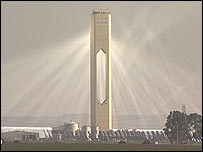
wild
places | wild happenings | wild
news
make a difference for our wild places
home | links | search the site
make a difference for our wild places
home | links | search the site
 |
wild
places | wild happenings | wild
news
make a difference for our wild places home | links | search the site |
| all articles latest | past | articles by topics | search wildnews |
|
wild
news on wildsingapore
|
| BBC
2 May 07 Power station harnesses Sun's rays By David Shukman Science correspondent, BBC News, Seville  There is a scene in one of the Austin Powers films where Dr Evil unleashes
a giant "tractor beam" of energy at Earth in order to extract a massive
payment.
There is a scene in one of the Austin Powers films where Dr Evil unleashes
a giant "tractor beam" of energy at Earth in order to extract a massive
payment. Well, the memory of it kept me chuckling as I toured the extraordinary scene of the new solar thermal power plant outside Seville in southern Spain. From a distance, as we rounded a bend and first caught sight of it, I couldn't believe the strange structure ahead of me was actually real. A concrete tower - 40 storeys high - stood bathed in intense white light, a totally bizarre image in the depths of the Andalusian countryside. The tower looked like it was being hosed with giant sprays of water or was somehow being squirted with jets of pale gas. I had trouble working it out. In fact, as we found out when we got closer, the rays of sunlight reflected by a field of 600 huge mirrors are so intense they illuminate the water vapour and dust hanging in the air. The effect is to give the whole place a glow - even an aura - and if you're concerned about climate change that may well be deserved. It is Europe's first commercially operating power station using the Sun's energy this way and at the moment its operator, Solucar, proudly claims that it generates 11 Megawatts (MW) of electricity without emitting a single puff of greenhouse gas. This current figure is enough to power up to 6,000 homes. But ultimately, the entire plant should generate as much power as is used by the 600,000 people of Seville. It works by focusing the reflected rays on one location, turning water into steam and then blasting it into turbines to generate power. As I climbed out of the car, I could hardly open my eyes - the scene was far too bright. Gradually, though, shielded by sunglasses, I made out the rows of mirrors (each 120 sq m in size) and the focus of their reflected beams - a collection of water pipes at the top of the tower. It was probably the heat that did it, but I found myself making the long journey up to the very top - to the heart of the solar inferno. A lift took me most of the way but cameraman Duncan Stone and I had to climb the last four storeys by ladder. We could soon feel the heat, despite thick insulation around the boiler. It was like being in a sauna and for the last stages the metal rungs of the ladders were scalding. But our reward was the cool breeze at the top of the tower - and the staggering sight of a blaze of light heading our way from down below. So far, only one field of mirrors is working. But to one side I could see the bulldozers at work clearing a second, larger field - thousands more mirrors will be installed. Letting off steam I met one of the gurus of solar thermal power, Michael Geyer, an international director of the energy giant Abengoa, which owns the plant. He is ready with answers to all the tricky questions. What happens when the Sun goes down? Enough heat can be stored in the form of steam to allow generation after dark - only for an hour now but maybe longer in future. Anyway, the solar power is most needed in the heat of summer when air conditioners are working flat out. Is it true that this power is three times more expensive than power from conventional sources? Yes, but prices will fall, as they have with wind power, as the technologies develop. Also, a more realistic comparison is with the cost of generating power from coal or gas only at times of peak demand - then this solar system seems more attractive. The vision is of the sun-blessed lands of the Mediterranean - even the Sahara desert - being carpeted with systems like this with the power cabled to the drizzlier lands of northern Europe. A dazzling idea in a dazzling location. HOW THE SOLAR TOWER WORKS 1. The solar tower is 115m (377ft) tall and surrounded by 600 steel reflectors (heliostats). They track the sun and direct its rays to a heat exchanger (receiver) at the top of the tower 2. The receiver converts concentrated solar energy from the heliostats into steam 3. Steam is stored in tanks and used to drive turbines that will produce enough electricity for up to 6,000 homes. links Related articles on Green energy |
| News articles are reproduced for non-profit educational purposes. | |
website©ria tan 2003 www.wildsingapore.com |